Witness the unfolding of biblical history through the Assyria map, where ancient stones whisper secrets of empires and prophecies yet to be explored.
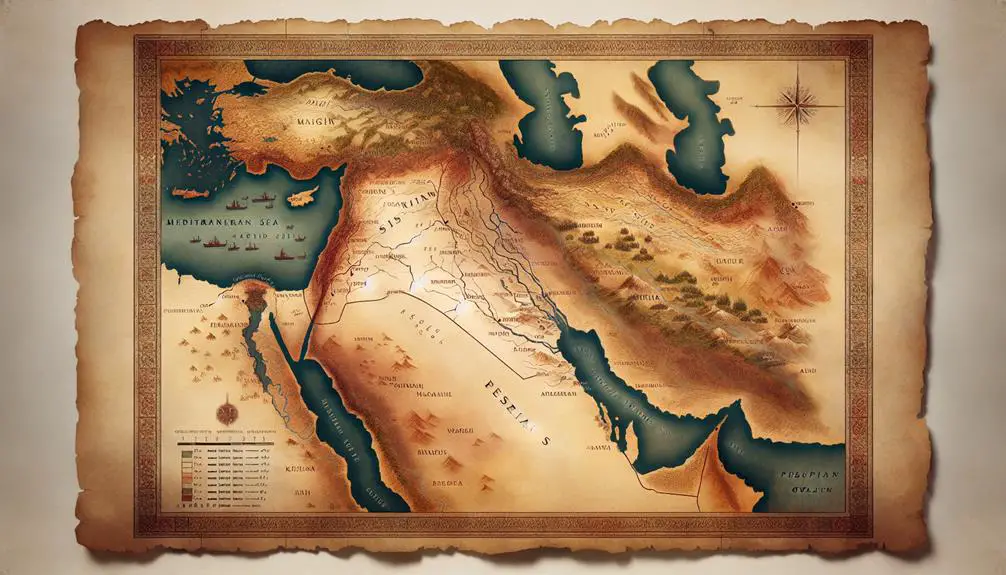
Assyria Map in the Bible
Just as the walls of Jericho fell, so too does the veil of mystery surrounding the ancient empire of Assyria when you glance at its biblical map. You've likely read about its vast territories and powerful kings, but have you ever considered how its geographical expanse influenced biblical narratives?
From the bustling streets of Nineveh to the decisive battles that shaped the fate of the Israelites, the map of Assyria unveils a story not just of conquest and empire but also of divine prophecy and intervention.
Let's embark on a journey to uncover how these ancient stones still speak to us today, beckoning with tales of intrigue and wonder.
Key Takeaways
- Assyria's vast territory covered parts of modern-day Iraq, Syria, Turkey, and Iran, reflecting its biblical significance.
- The Bible depicts Assyria's interactions with Israel, highlighting military conquests and cultural clashes.
- Assyria's capitals, as centers of power and culture, are crucial for understanding its biblical representation.
- Prophetic narratives in the Bible involving Assyria emphasize divine justice and the nation's eventual downfall.
The Geographic Scope of Assyria
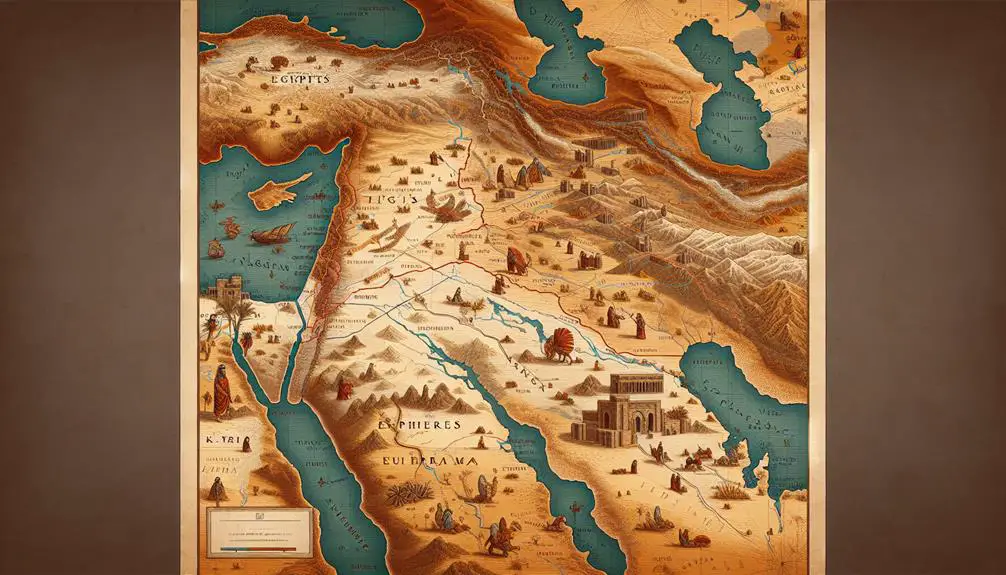
Understanding the geographic scope of Assyria is crucial, as it illuminates the empire's expansive reach and strategic dominance in the ancient Near East. This empire, flourishing between the 25th century BCE and 605 BCE, wasn't just a political force but also a master of climate adaptation and trade route development. Its territory, at its zenith, stretched from the Tigris River in the east to the Mediterranean Sea in the west, encompassing what's now modern-day Iraq, Syria, Turkey, and parts of Iran.
Assyria's success was partly due to its strategic location, which allowed it to control vital trade routes. These routes were lifelines for commerce, connecting the Mediterranean to the heart of Asia. Through them, Assyria facilitated the exchange of goods, cultures, and ideas, enriching its society and economy. Moreover, its ability to adapt to the diverse climates within its territory—from the arid deserts of the Middle East to the more temperate regions in the north—enabled Assyria to develop a highly efficient agricultural system. This system supported not just the local population but also the empire's extensive military campaigns.
Assyria in Biblical Context
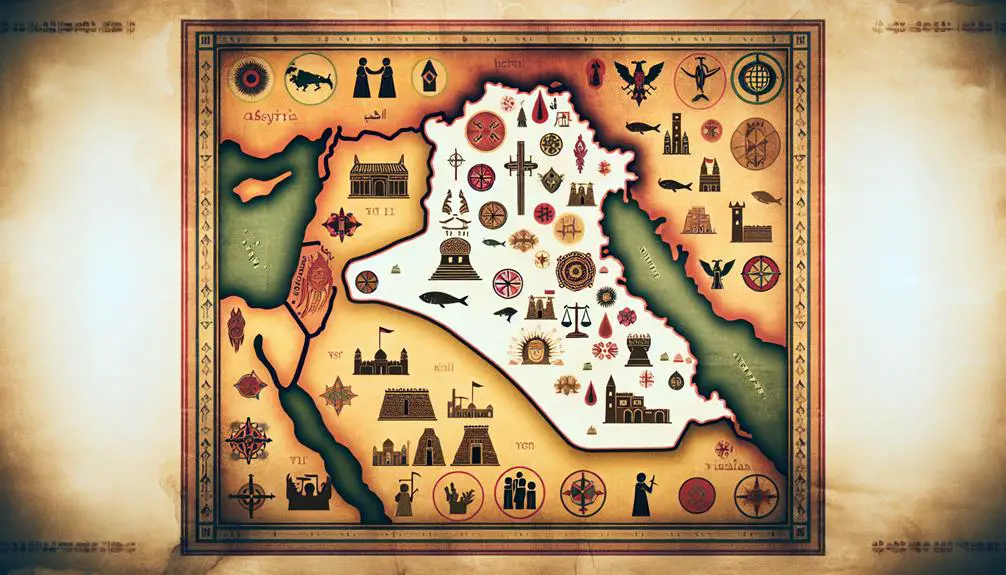
Having explored the geographic expanse and strategic dominance of Assyria, let's now examine its significant role and portrayal in the biblical narrative, reflecting on its interactions and impact on the ancient Israelites. Assyria's mention in the Bible isn't just a testament to its military conquests but also shines a light on the profound cultural and religious practices that influenced, and at times, conflicted with those of the Israelites.
You'll find that Assyria's religious practices, particularly its polytheistic worship, starkly contrasted with the monotheism of the Israelites. This divergence not only fueled ideological disputes but also facilitated a complex relationship where assimilation and resistance coexisted. Assyrian gods and their worship practices are detailed in biblical accounts, serving as a backdrop for prophetic warnings against idolatry among the Israelites.
Cultural influences from Assyria seeped into Israelite society, not merely through conquest but also via trade, intermarriages, and the exchange of ideas. This amalgamation of cultures is reflected in the archaeological and historical records that echo biblical narratives, offering insights into how Assyrian customs and language subtly shaped Israelite daily life, administrative systems, and even religious practices.
However, it's crucial to discern that the Bible often frames Assyria within a theological context, portraying it as an instrument of divine judgment against Israel's apostasy. This perspective emphasizes the moral and spiritual lessons derived from Assyria's interactions with the Israelites, highlighting the consequences of straying from covenantal faithfulness.
Major Cities and Capitals
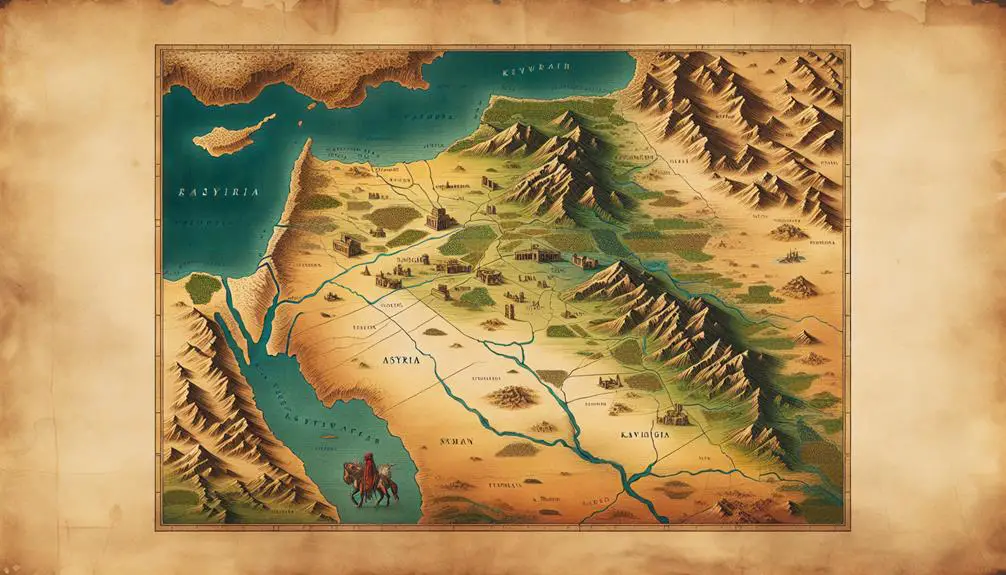
As you explore the Assyria map in the Bible, it's crucial to examine its prominent capitals and key urban centers, which served as the heart of its political, economic, and religious life.
These cities, each with its unique contributions and historical significance, played pivotal roles in shaping Assyria's legacy within the biblical narrative.
Understanding their geographical placement and historical context offers deeper insights into Assyria's complex society and its interactions with neighboring civilizations.
Assyria's Prominent Capitals
The ancient Assyrian empire boasted several prominent capitals, each serving as a pivotal hub for political, economic, and cultural developments. These cities were marvels of palace architecture, showcasing the Assyrians' advanced understanding of both aesthetics and function.
The grandeur of these palaces didn't just symbolize power; they were central in implementing economic strategies that propelled Assyria to the forefront of ancient civilizations. Trade, taxation, and agricultural management were orchestrated with precision, ensuring the empire's prosperity and stability.
Moreover, these capitals weren't merely administrative centers; they were the heart of Assyrian culture, where art, religion, and knowledge converged, reflecting the sophistication and complexity of Assyrian society. Through meticulous planning and governance, Assyria's capitals stood as testaments to its enduring legacy.
Key Urban Centers
Within the heart of the ancient Assyrian Empire lay key urban centers, each serving as a vital node in its extensive political, economic, and cultural network. These cities weren't merely administrative capitals; they were hubs of innovation and power that significantly impacted the surrounding regions.
Their strategic locations along major trade routes facilitated not only wealth accumulation but also cultural exchange, reinforcing Assyrian dominance. The cultural influence emanating from these centers was profound, shaping the identity of the Assyrian Empire and its legacy.
Consider the following aspects that underscore their significance:
- Their position along trade routes enhanced economic prosperity and political leverage.
- They were centers of cultural production and dissemination.
- Their architectural and administrative innovations set standards across the empire and beyond, illustrating their central role in Assyria's success.
Assyria and the Israelites
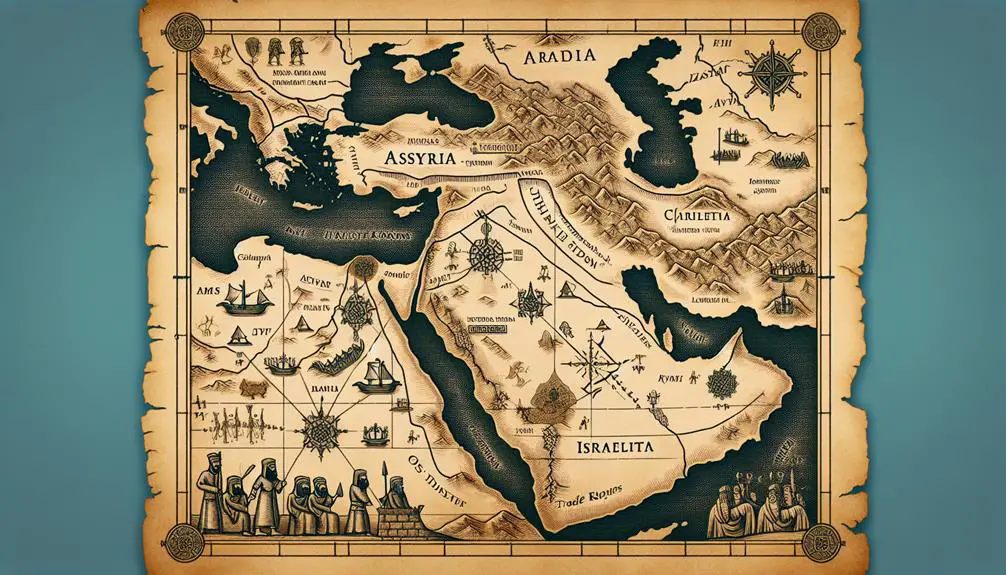
ARTICLE TITLE: Assyria Map in the Bible
PREVIOUS SUBTOPIC: 'Key Urban Centers'
CURRENT SUBTOPIC: 'Assyria and the Israelites'
Historically, Assyria's interactions with the Israelites profoundly shaped the geopolitical and cultural landscapes of the ancient Near East. You'll find that Assyrian conquests led to significant cultural assimilation, impacting religious practices among the Israelites. Assyria's advanced military and administrative strategies enabled them to exert considerable influence over the captured Israelite territories, leading to a complex blend of cultures and beliefs.
Aspect |
Impact on Israelites |
|---|---|
Cultural Assimilation |
Introduced Assyrian customs and languages, leading to a blend of Assyrian and Israelite traditions. |
Religious Practices |
Assyrian polytheism influenced Israelite monotheism, introducing syncretism in some regions. |
Administrative Control |
Assyrian governance models were imposed, altering local administration and societal structures. |
This table encapsulates the nuanced impacts of Assyrian rule on the Israelites, highlighting the transformation in cultural and religious spheres as well as governance. The imposition of Assyrian administrative practices, for instance, not only restructured local governance but also facilitated the spread of Assyrian culture and language among the Israelites, promoting a degree of cultural assimilation. Furthermore, the interaction between Assyrian polytheism and Israelite monotheism led to religious syncretism in certain areas, complicating the religious landscape.
In analyzing these dynamics, it's clear that Assyria's influence extended beyond mere conquest, deeply affecting the cultural and religious fabric of Israelite society. This period of Assyrian dominance serves as a critical chapter in understanding the complex interplay of cultures and religions in the ancient Near East.
Key Battles and Conquests
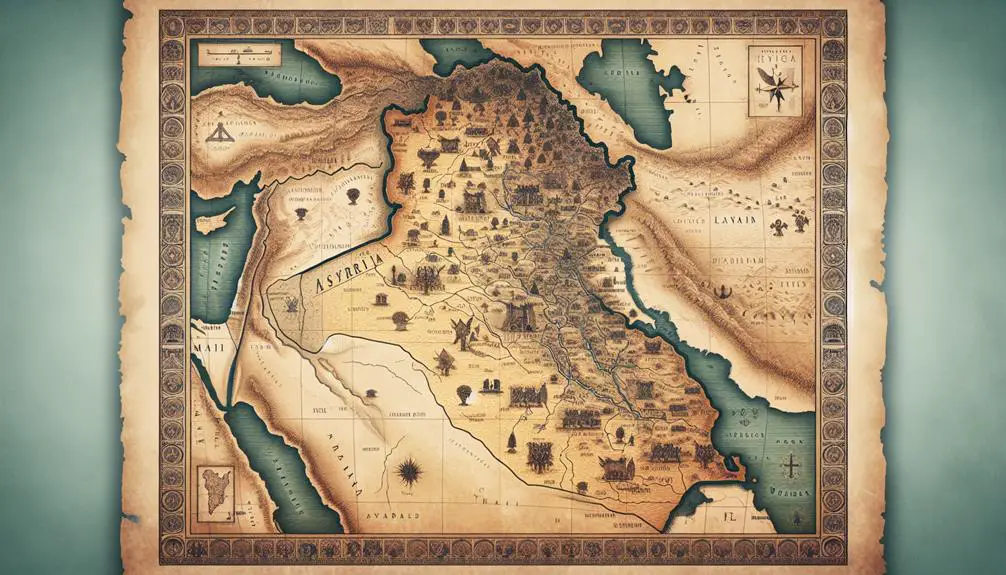
Exploring further, we'll now examine how Assyria's military campaigns and victories over the Israelites not only reshaped geographical boundaries but also left indelible marks on the socio-political landscape of the region. The Assyrian empire, renowned for its mastery in warfare, employed advanced military tactics and siege engineering to subjugate territories and expand its dominion.
You'll find that Assyria's approach to warfare was methodical and strategic. The empire's military prowess was underpinned by several key factors:
- Superior Siege Engineering: Assyria's ability to besiege fortified cities was unmatched. They utilized battering rams, siege towers, and earthworks to breach defenses, demonstrating an advanced understanding of military engineering.
- Psychological Warfare: By spreading terror before their arrival, they weakened enemy morale. The graphic depictions of torture and the fate of defeated enemies served as a psychological tool to ensure swift surrender of cities.
- Innovative Military Tactics: Assyrian commanders were adept at employing a range of tactics, including the use of cavalry for quick assaults and archers for long-range attacks. This versatility on the battlefield allowed them to adapt to different enemies and terrains effectively.
The conquest of the Northern Kingdom of Israel stands as a testament to Assyria's military might. This campaign not only demonstrated their ruthless efficiency but also marked a pivotal moment in the region's history, leading to the dispersion of the ten Israelite tribes. The strategic sieges, coupled with the forced relocation of populations, significantly altered the demographic and cultural composition of the Near East.
Prophets and Assyrian Kings
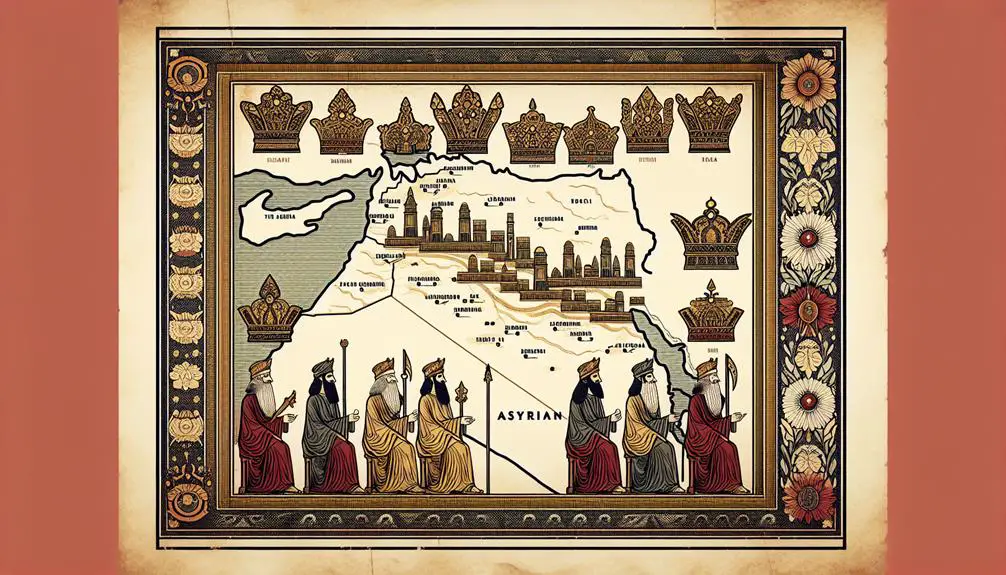
You'll find that the interactions between prophets and Assyrian kings in the Bible are marked by prophetic warnings and the kings' unique roles within the biblical narrative.
These warnings often served as divine responses to the Assyrians' actions, highlighting a complex relationship between divine prophecy and royal authority.
Analyzing these encounters provides insight into the theological and political dynamics of the time, reflecting on how power and prophecy influenced the course of history.
Prophetic Warnings to Assyria
Throughout history, biblical prophets issued stern warnings to Assyrian kings, foretelling the empire's downfall due to its hubris and oppression. These warnings often highlighted:
- Divine interventions: Prophets like Isaiah and Jonah emphasized that divine powers would actively work against Assyria unless the nation altered its path.
- Assyrian repentance: Instances of repentance, notably in Nineveh under Jonah's preaching, temporarily averted disaster, showing a complex relationship between divine mercy and human action.
- Inevitable downfall: Despite moments of repentance, the prophetic narrative consistently points to Assyria's eventual destruction due to its sustained cruelty and idolatry.
This analysis underscores a recurring biblical theme: the interplay of divine justice with human morality, offering a nuanced view of Assyria's historical and spiritual trajectory.
Assyrian Kings' Biblical Roles
In the biblical narrative, Assyrian kings often serve as both adversaries and instruments in the unfolding of prophetic messages, illustrating a complex interplay between divine will and royal authority.
You'll find that royal decrees and dynastic succession are key themes that underscore this complex relationship.
Royal decrees, often issued by these kings, not only assert their earthly power but also, inadvertently, fulfill divine prophecies.
Similarly, the pattern of dynastic succession among Assyrian rulers reveals a divine orchestration at work, guiding the historical and spiritual trajectory of both Assyria and the Israelite nations.
This intricate dance between prophecy and royal action emphasizes the sovereignty of divine will, casting the Assyrian kings in roles that transcend their immediate political and military ambitions.
Artifacts and Archaeological Evidence
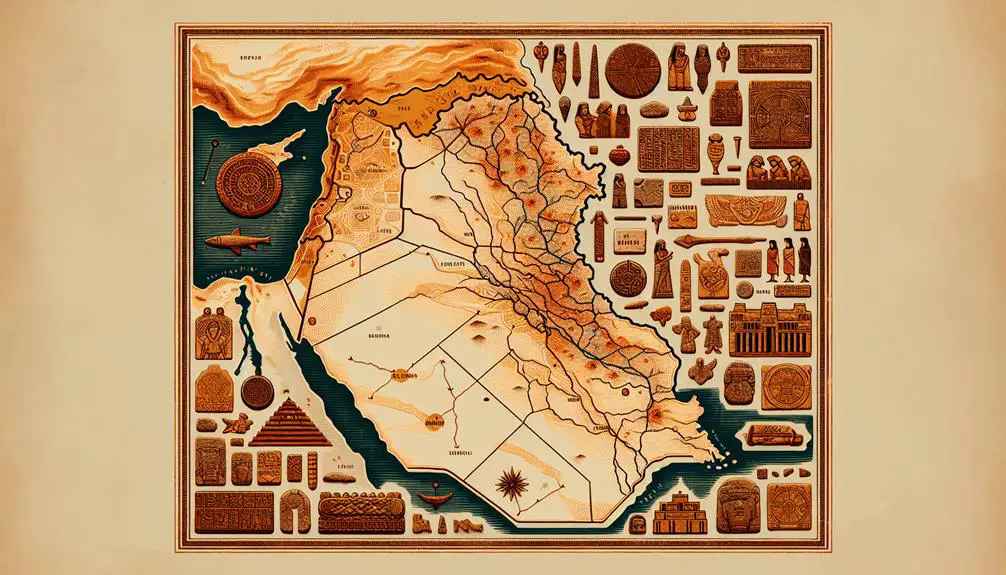
Examining the wealth of artifacts and archaeological evidence, it becomes clear that Assyria's historical and cultural impact on the ancient Near East is profound and multifaceted. This evidence provides a tangible link to the world described in the Bible, offering insights that text alone cannot. Among the myriad of findings, pottery styles and inscription analysis stand out, shedding light on Assyria's extensive trade networks, social hierarchies, and even diplomatic relationships with neighboring states.
Pottery, the most ubiquitous of archaeological finds, serves as a chronological marker that helps historians piece together Assyria's expansive timeline. The evolution of pottery styles from simple, functional designs to more intricate and stylized forms reflects not only advancements in technology but also the flourishing of Assyrian culture and its interactions with neighboring civilizations.
Inscription analysis offers another layer of understanding. These inscriptions, often found on stone monuments, clay tablets, and palace walls, contain a wealth of information about Assyrian society, including:
- Legal Codes: Detailed laws and regulations that governed daily life, highlighting the complexity of Assyrian society.
- Diplomatic Correspondence: Letters and treaties with other states, revealing Assyria's diplomatic prowess and its role within the intricate web of ancient Near Eastern politics.
- Royal Annals: Chronicles of kings' reigns, providing insight into Assyria's military campaigns, construction projects, and religious practices.
Together, these artifacts form a multifaceted picture of Assyrian life that complements and enriches our understanding of its mention in biblical texts. They bridge the gap between the ancient and modern worlds, offering a vivid glimpse into one of history's great empires.
Frequently Asked Questions
How Do Modern Assyrians Relate to the Ancient Assyrian Empire Described in the Bible?
You'll find that modern Assyrians often see their cultural identity as directly tied to the ancient Assyrian empire. Despite the centuries and the dispersion of the Assyrian people into a global diaspora community, there's a profound sense of continuity.
They actively preserve their language, religion, and traditions, which are deeply rooted in their ancestral heritage. This connection enriches their sense of belonging and provides a unique lens through which they view their history and culture.
What Are the Academic Challenges in Translating and Interpreting Assyrian Texts for Biblical Studies?
You're facing significant academic challenges when translating and interpreting Assyrian texts for biblical studies. The linguistic variances among ancient languages, including dialectal differences and evolving syntax, complicate your understanding.
Additionally, decipherment methodologies require a deep knowledge of not just the languages but also the historical and cultural contexts. These complexities demand a scholarly approach, where meticulous analysis and cross-referencing with contemporary texts are crucial for accurate interpretation.
How Has the Portrayal of Assyria in the Bible Influenced Its Perception in Contemporary Religious Teachings?
The Bible paints Assyria as a double-edged sword, shaping its modern perception significantly. Through stories of divine retribution and prophetic narratives, you're shown how Assyria served as both a scourge for punishment and a tool for divine lessons.
This complex portrayal influences contemporary religious teachings, casting Assyria in a light that's both feared and understood within a divine framework, encouraging a deeper exploration of morality and divine justice.
Are There Any Significant Environmental Changes in the Ancient Assyrian Region That Have Affected Archaeological Explorations?
Yes, there have been significant environmental changes in the ancient Assyrian region that've impacted archaeological explorations. Climate impact studies indicate alterations in weather patterns and a rise in desertification. These changes have posed challenges, making it tougher to locate and preserve ancient relics.
Desertification, in particular, has led to the loss of potentially valuable sites. As you delve into these explorations, it's crucial to consider how these environmental shifts have reshaped the archaeological landscape.
What Role Do Non-Biblical Sources Play in Understanding the Historical Context of Assyria's Interactions With Neighboring Civilizations?
Non-biblical sources are crucial for you to understand Assyria's historical interactions with neighboring civilizations. They provide detailed insights into Assyria's military strategies and artistic depictions, enriching your knowledge beyond biblical narratives.
Conclusion
Intriguingly, while you've been exploring the vast landscapes of Assyria's biblical map, a world where prophets and kings tread, it's almost as if the past has been whispering secrets.
Amidst the ruins and relics, a tale of power, faith, and conflict unfolds, coincidentally mirroring our own quests for understanding.
This scholarly journey into Assyria, marked by its cities, battles, and divine messages, not only enriches our grasp of ancient narratives but also illuminates the interconnectedness of history and faith.



Sign up